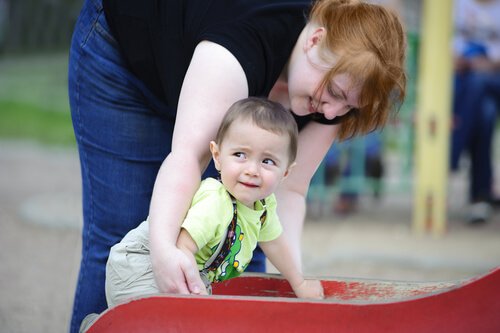The Strange Situation Procedure to Assess Attachment

Attachment is the bond that exists between two people that’s characterized by intense emotion. Normally, it’s a lasting relationship with a special and binding component. Mary Ainsworth pioneered the development of the first tool to assess attachment in children. Her procedure is known as Strange Situation.
This mother-child bond doesn’t manifest exclusively in humans. It also manifests in many animals. However, humans require a longer time to form this bond. Attachment is consolidated when unconditionality exists between two people.
The goal of attachment
It’s essential for a child’s first attachments to be healthy. The purpose of attachment, therefore, is to achieve safety, comfort, protection, and the satisfaction of the baby’s basic needs. Thus, depending on the attachment style they develop with their caregivers, children can show more or less proximity, emotional refuge, protest against separation, and a basis of security.
This bond not only influences the child’s immediate well-being, but also marks their psycho-evolutionary development. Therefore, attachment deficiencies can affect them well into adulthood.

Necessary conditions for attachment to take place
For the first attachment to form, the baby must meet a series of minimum conditions. These requirements guarantee that the attachment will develop appropriately:
- Have a sufficient repertoire of attachment behaviors. Milestones, such as smiles or babbles and following and approaching the mother.
- These behaviors must attract the adult, establishing and producing privileged interactions between both.
- Have minimal affective abilities.
- Possess a series of minimum cognitive resources to recognize the adult, accumulate memories, and forge expectations regarding their attachment figure.
The Strange Situation procedure
The Strange Situation procedure is a laboratory process designed by American psychologist Mary Ainsworth in 1960. Its objective is to study the interaction that a mother or an adult (stranger) maintains with the child in an unfamiliar environment. It’s been so popular in the psychology of development that it’s still used today to classify and assess attachment styles.
Simulations
The Strange Situation procedure tries to simulate certain contexts to analyze how children behave outside of their comfort zone. In other words, how children transition from the safe environment of their home and explore another unknown location. Through observation, the researchers study children’s reactions when they’re separated from their mothers and then when they’re reunited.
This simulation consists of eight episodes meant for children around the age of one. The relationship between baby and caregiver should be clearly established around this time.

Procedure
In one of the most common variations of this procedure, Ainsworth placed the child next to their mother in a room full of toys. After a while, a stranger entered the room and the mother left, leaving the child with the stranger. Then, the mother came back in. Later, both she and the stranger left the room and left the child alone. Then, the stranger entered again.
With this, the psychologist evaluated the reactions and interactions that occurred between the attachment figure, the child, and the stranger.
Attachment styles
The Strange Situation procedure has established three attachment styles: secure, evasive and ambivalent.
- A secure attachment is evident when the child freely explores the environment when separated from their caregiver. They feel anguish at their mother’s departure, but enthusiastic when she returns.
- Evasive attachment is also characterized by the anguish the little one experiences when their mother leaves. But unlike in a secure attachment, they tend to avoid their mother when she returns.
- Insecure/ambivalent attachment shows signs of anguish throughout the process. The child shows anger toward their caregiver, especially when they’re absent.
A child’s attachment doesn’t fully determine their personality or the quality of their adult relationships. However, it can influence these factors and the interactions established at later stages of development.
This text is provided for informational purposes only and does not replace consultation with a professional. If in doubt, consult your specialist.








